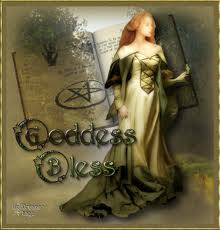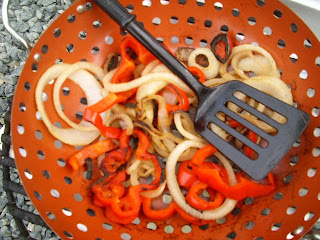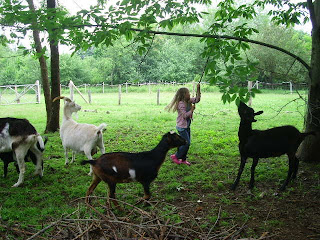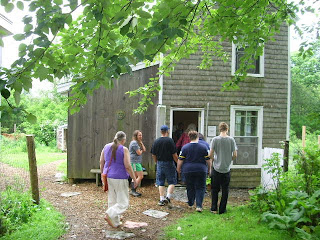I want to share some thoughts on each chapter of this book. It is a great book called, "Mind if I Order the Cheeseburger? And Other Questions People Ask Vegans" by Sherry Colb.
This book is a really valuable guide for vegans seeking to give good, confident answers to common questions asked to us by nonvegans. It also gives tips for how to deal with these questions in a graceful manner when they may make us feel angry or defensive. I know that has happened to me and I wish I had read the book beforehand.
Colb is very gracious to nonvegans. She says again and again that nonvegans often don't mean to be offensive when they ask the questions, and we just feel that way. I can personally testify that many nonvegans DO mean to be offensive and are in full blown attack mode when they bring up some of these topics. But then again, most of the people I know are nonvegans and I really like most of them. I love some of them. I know they are generally good people. But even when vegans don't say anything specific about our beliefs, our mere presence in some people's lives seems to make them feel really defensive. But Colb's gracious, calm approach and good information make it a lot easier to deal with both kinds of nonvegans.
I do agree with her that we need to be calm, friendly, and nondefensive as much as possible when dealing with nonvegans. I know some days I can do that and some days a nonvegan rubs me the wrong way. It usually has more to do with how I'm feeling than the person talking to me. Not always. As I've said, some people just attack and it's impossible not to take it that way.
When an interaction is unwanted or aggressive I often avoid their questions or feel really angry. I've never been overtly rude to anyone in that situation but I have felt bad about some interactions. And I've always wished afterwards that I had said or done something better. That is why I grabbed this book immediately after hearing it reviewed on the Our Henhouse podcast.
Every time we have a good interaction with a nonvegan, it helps to break down stereotypes that help nonvegans dismiss us and the facts under veganism as "fringe" or "crazy" or "not realistic." And that has wide spread repercussions for us, for the environment, and for animals. And even for the nonvegan him or herself, if our information goes on to make their lives healthier and better. Win-Win for everybody! Well, except big ag and big pharma.
It helps to have good answers to these questions. I will therefore do a brief summary of Colb's chapters in this blog, along with my own thoughts. I don't mean to imply that you get the full value of the book by reading my posts, of course. I highly, highly recommend buying it, and/or gifting it.
In the introduction, Colb defines "vegan." She explains how some nonvegans like to think of veganism as a phase or as unrealistic extremeism. She basically suggests that we 1) know our reasons for being vegan and 2) calmly, simply express them. This is the ongoing theme of the book.
She defines veganism in this way: "Vegans avoid participating in violence toward animals. This means they refuse to purchase and consume animal flesh, dairy, eggs, and other products of animal slaughter and exploitation, such as wool, leather, and fur. In her daily choices, the vegan thereby freely chooses not to contribute to the carnage and suffering associated with the breeding and slaughter of animals. Her daily life expresses her commitment to compassion and non-violence, and her interaction with her world as one of caring."
This is a lot more detail than I have ever gone into when telling people what vegan means. If they ask, I usually say "I don't use any animal products." If they look puzzled, I list some, usually starting with dietary and if they seem friendly, add the other stuff (clothing, shoes, products). Usually if people ask me, it is in a food related context so the most important thing I convey is the dietary aspect. Like someone at a potluck at work might ask me why I'm trying to figure out what's in their salad, for example.
Then Colb gives a quick summary of what she thinks the most important talking points are for explaining veganism to people. These talking points include, as "the simple case for veganism":
Health.
Environment.
Animals.
I agree with her talking points and was gratified to see them since I took a similar approach in my article, "An it Harm None: Vegans in the Pagan Community" which was run in the last issue of Circle Sanctuary Magazine (Issue 114). In my article I included all three of these points as reasons people are vegan, and I also included weight loss and fitness as seperate categories. My article is in the back issues at Circle's website, by the way:
http://www.circlesanctuary.org/store/index.php?route=product/product&path=42&product_id=607
Health: she discusses how animal based foods increase risk of cancer, heart disease, diabetes, and other health conditions. She puts forth some of the info from researchers like Colin Campbell. I would suggest that the whole argument can be easily and enjoyably learned by watching and rewatching "Forks over Knives" a few times.
Environment: She references the 2006 UN report, "Livestock's Long Shadow" (and other studies) and briefly introduces people to the impact animal agriculture has on the environment. Basically she is touching on the connections between animal consumption and global climate change, species extinction, and world hunger. I like the website
www.awellfedworld.org for gleaning more info on this topic. The movie "Vegucated" also gives brief and very understandable summaries of this (and all the other) talking point.
Animals: Colb believes that the general public basically knows factory farming is cruel. She talks as if many people have already seen something like "meet your meat" or at least some news footage about the innumerable animal agriculture cruelty investigations. The media piece may be true but I tend to think people are in much more denial about the animal cruelty of their food choices than Colb seems to. Especially in my area, which is rural and filled with small farming operations, people like to believe that small farms are not cruel and that killing animals who "were happy" is somehow ethical and nature's law. For instance, I photographed a sign on a booth at our state's huge organic farming fair last summer that read, "Happy Pigs Taste Better." Anyhow, Meet Your Meat online is a bracing but informative piece about the animal issues. I have found that Farm Sanctuary has very informative brochures about factory farming, and they do not have slaughter footage so they are less traumatic for nonvegans to read. Brochures like this can often be purchased or downloaded from places like
www.farmsanctuary.org or Compassion Over Killing:
www.cok.net. But I have to give it to Colb, people do seem to know more than they admit they know if you can catch them not feeling defensive. Just yesterday someone at work asked me about my smoothies and asked if I was "one of those granolas," to which I explained I was a vegan, and what it meant (the no animal products answer). She thought about it a second and then started talking about all the stuff she knew about animal agriculture. She has been to a big hen operation when she was in grade school and seen them burning the tips off hens beaks, and been horrified. And she had heard where veal came from and she no longer ate veal. She went on about a few more things. And she asked me, "but if you know where the stuff comes from it's okay, right? Like I have a friend who makes goat cheese." And in that moment I made a snap decision and just shrugged and said, "sure, if you absolutely know where it's coming from and how the animals are treated. It's just that out in restaraunts and stores and everywhere else I have no way of knowing, so I just avoid animal products." And she accepted that and stayed friendly. So I felt comfortable with that way of talking about it with her because we did discuss a lot of animal cruelty without her shutting down.
In the rest of the intro, Colb does discuss how veganism makes nonvegans feel defensive and uncomfortable, so she underscores again the purpose of her book: that giving thoughtful, well educated replies to them makes your life easier and forwards the spread of veganism. Even if the person talking to you doesn't become vegan, they have just gotten more info and who knows how that may spread. And they have also had a vegan talk with them in a calm, informative manner so they hopefully will be less defensive around other vegans. And who knows where that will lead. As activists everything we do matters.
Recently someone at my pagan temple was working in the kitchen with gwen and I when we were serving at a buffet. She asked several questions about "is this vegan?" or "is that vegan?" and "can you eat (fill in the blank)?" and after a while of this she said to us, "it's just so nice that you two are just open about what you believe without being preachy."
I know she meant that as a compliment but it was still frustrating to me. Where are all the preachy vegans I keep hearing about? As a board member on our statewide vegan organization and a coordinator of local vegan meetups, I think I know at least half the vegans in the area. When we go out together we are always amongst nonvegans, since we are an extreme minority here. Yet I have never heard or seen a vegan verbally assaulting or guilting a nonvegan. I know it happens somewhere and sometimes, but it can't be the epidemic nonvegans imply it is. On the other hand I have seen at least half a dozen verbal assaults on vegans by nonvegans, and directly experienced several. So I personally think it's a lot of projection on the part of nonvegans. But I still know that those moments when a nonvegan concedes that we're "all" not preachy and confrontational is a victory for veganism, so I sigh internally and press on.
I think the film Vegucated is a good summary of all these three basic arguments, actually. So I recommend a film fest of Vegucated and Forks over Knives to get comfortable with the arguments. Some vegan potlucks including a screening of one of these films wouldn't hurt either. Maybe with a plug for this book in the process.
Next time I post on this book I will do chapter one: What About Plants?




























































